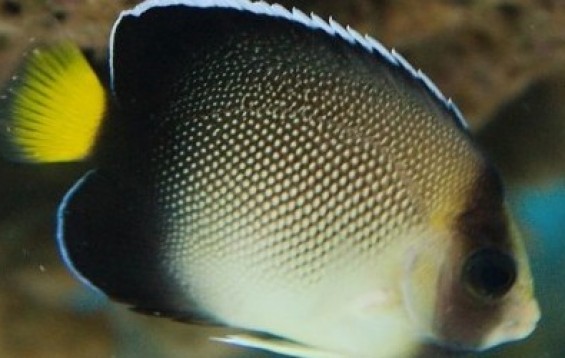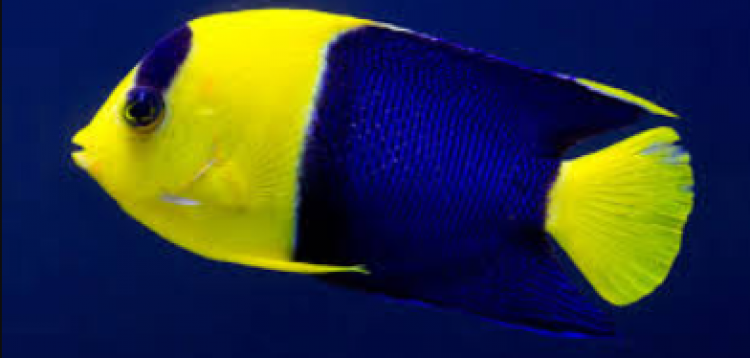- Name:
Xanthurus Cream Angelfish
(View AKA's) - Family: Pomacanthidae
- Species: Angel Large
- Scientific Name: Apolemichthys xanthurus


General info about Xanthurus Cream Angelfish
The Xanthurus Cream Angelfish true to its Latin name, the caudal fin is yellow. The dorsal fin is outlined with a silvery-white line. The Xanthurus Cream Angelfish adapts readily to aquarium life. It requires a large tank with lots of hiding places and live rock for grazing will offer an environment in which to thrive. It is prone to nip at stony and soft corals (sessile invertebrates) and clam mantles. Only one specimen should be kept per tank. It is hermaphroditic, and there are no distinguishing features which differentiate males from females.
Xanthurus Cream Angelfish Diet & Nutrition
Indian Yellowtail angelfish are omnivores. They are mostly herbivores found grazing off algae in rocks, sponge material, tunicates, and small amounts of compepods.
Determining Sex of Xanthurus Cream Angelfish
Indian Yellowtail angelfish does not display sexual dimorphism however, males are often the larger individual.
Breeding & Spawning Xanthurus Cream Angelfish
Angelfishes are broadcast spawners. Courtship usually starts just before sunset when the male will swim above the female, tilts his body and extends his fins, awaiting for a response from the female. When ready, the female will swim towards the area which the male designated as their spawning area. The pair will then soar above the water column as the male nuzzles the female belly. Simultaneously, both will release their gametes into the water column for fertilization.
Common Diseases with Xanthurus Cream Angelfish
Angelfishes such as the Yellowtail Angelfish might be able to contract common bacterial diseases such as Cotton wool disease, Vibrio bacterial disease, and Fish tubercolosis. Cotton wool disease is exhibited as an expanding translucent layer that eats away on the skin. Vibrio Bacterial disease on the other hand are exhibited by Dropsy, Popeye, Bleeding or Red Streaks on the skin. Lastly, Fish T.B. usually shows up as a loss of color and swelling of the body. It can also display blood streaks and blood spots anywhere in the body.
Aside from bacterial diseases, angelfishes my be affected by common reef scourges such as the Crypt or White Spot Diseases and Velvet Disease. Tiny white spots on the skin of the fish is one of the tell-tale sign of infection of the Crypt while dusty golden film on the skin or the eyes of the angelfish will detect the presence of Velvet Disease.
Xanthurus Cream Angelfish Origin
This fish species are often found in the Western Indian Ocean, which also includes the Mauritius, Maldives, Sri Lanka and India’s east coast. An odd reported sighting, which was obviously an aquarium release, was found off Osezaki, Japan.
Caution with Xanthurus Cream Angelfish
This angelfish is moderately hardy and one of the easiest to keep from the Apolemichthys genus. They will readily accept a wide range of prepared foods. But like any angelfish, having live rock with lots of algae growth along with live sponges and tunicates will help to acclimate a picky eater.
Acclimating Xanthurus Cream Angelfish
A mature tank of at least 75 gallons with several rocks for hiding place is required for this angelfish. They only become aggressive toward their own kind and other fish that are added after them if they are kept in a tank that is too small. They are not considered reef safe. Invertebrates such as larger shrimp, crabs and snails are safe, but they will consume all other types of corals. Even as juveniles they will pick at and eat soft polyp corals, especially Xenia and Anthelia, as well as stony corals and zoanthids.
Original Detail
| Name | Species | Family | Scientific Name | More Detail | Added by |
|---|---|---|---|---|---|
| Xanthurus Cream Angelfish | Angel Large | Pomacanthidae | Apolemichthys xanthurus | The Xanthurus Cream Angelfish true to its Latin name, the caudal fin is yellow. The dorsal fin is outlined with a silvery-white line. The Xanthurus Cream Angelfish adapts readily to aquarium life. It requires a large tank with lots of hiding places and live rock for grazing will offer an environment in which to thrive. It is prone to nip at stony and soft corals (sessile invertebrates) and clam mantles. Only one specimen should be kept per tank. It is hermaphroditic, and there are no distinguishing features which differentiate males from females. |
PalaciosAn |


